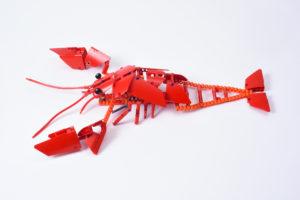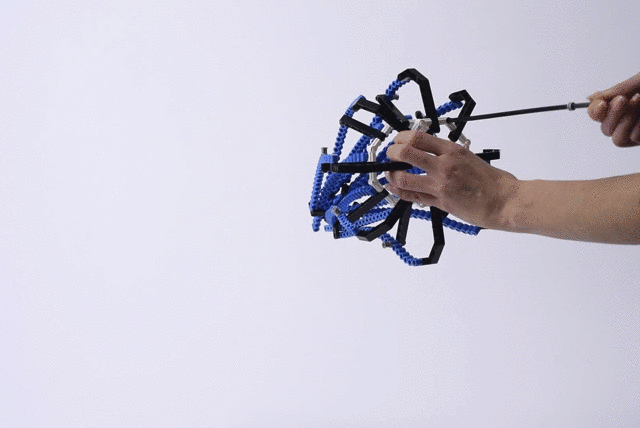 A Kickstarter campaign just launched for what is arguably the coolest toy this year: bionicTOYS are inspired by the science of motion and nature’s own flexibility, and introduce STEM-based skills to children. Berlin-based product designer and LEGO enthusiast Marcel Pasternak created bionicTOYS in 2016 as part of his master’s thesis in product design. The patent-pending, flex-brick design lets kids (and adults!) replicate organic actions found in nature, like how a claw grasps and a shark swims.
A Kickstarter campaign just launched for what is arguably the coolest toy this year: bionicTOYS are inspired by the science of motion and nature’s own flexibility, and introduce STEM-based skills to children. Berlin-based product designer and LEGO enthusiast Marcel Pasternak created bionicTOYS in 2016 as part of his master’s thesis in product design. The patent-pending, flex-brick design lets kids (and adults!) replicate organic actions found in nature, like how a claw grasps and a shark swims.
The collection, found exclusively on Kickstarter, reimagines construction-based play. It’s colorful and easy to use, so kids and their parents, teachers and design enthusiasts, and LEGO fans can explore all the creative doors it opens. The bricks can be used alone, and are also compatible with other building block toys, such as TinkerBots and LEGO Technic. Since they’re so flexible, kids can create designs that mimic real animal movement, like crawling, flying, and grasping. Not only is it pretty fun, but it can also translate into STEM-based knowledge in bionics, physics, and mechanics, like the principles of elasticity, friction, recoil, and potential energy.
 A bionicTOYS set is available on Kickstarter for between $16-$84; a gift for you, your kid, and your wallet! There will also be larger sets, as well as TinkerBots sets, available for between $126-$306. Each set you buy on Kickstarter will include all the necessary pieces to construct one thing, like a jellyfish, or a claw. Be forewarned, instructions do not come with the sets, but instructional videos can be found on their website. Pasternak used 3D printing to develop the perfect elasticity in the bricks, so he was able to create a special toy set that mimics animals’ actions, like how a frog jumps, and again focuses on those STEM skills, like seeing how that frog’s leg has the same mechanical principles as a catapult.
A bionicTOYS set is available on Kickstarter for between $16-$84; a gift for you, your kid, and your wallet! There will also be larger sets, as well as TinkerBots sets, available for between $126-$306. Each set you buy on Kickstarter will include all the necessary pieces to construct one thing, like a jellyfish, or a claw. Be forewarned, instructions do not come with the sets, but instructional videos can be found on their website. Pasternak used 3D printing to develop the perfect elasticity in the bricks, so he was able to create a special toy set that mimics animals’ actions, like how a frog jumps, and again focuses on those STEM skills, like seeing how that frog’s leg has the same mechanical principles as a catapult.
“My 3D printer is an everyday life tool for me. It gives volume to my conceptual thoughts like no other tool can,” Pasternak told 3DPrint.com. “The haptic experience of my design is just as important as the 3D visualizations on the screen. This is particularly important with bionicTOYS, with which I’m trying to communicate a more hands-on understanding of how natures moves. Of course, I like to also go outside into nature, explore my surroundings and get inspired. And then with that, apply that knowledge to materials through 3D printing.”
After the Kickstarter campaign is over, the flex-bricks will be produced in Germany through injection molding, using TPU with a food contract certification; this makes it safe for children 36 months and older. The production will have two types of flexibility available in the bricks. The Stretchy Flexibility brick is the more flexible of the two, and has the best gripping properties; it’s available in fox-red and grass-green colors. The Boogy brick (love the name) is stronger, but still pretty bendable; it’s available in pumpkin-orange and sky-blue. You can cut the bricks with scissors to shape them however you want, but they’re still strong enough to hold 44 lbs. of weight!
 A case study was completed on the bionicTOYS, about the future of flexibility. Pasternak wanted to introduce a new way of interacting with building blocks, to use them as a way to foster a more hands-on understanding of the laws of nature. He began introducing his flex-brick construction sets through educational programs at schools. In less than a year, his original design grew into an educational toy company. By working one-on-one with the children, he was able to test his idea’s potential as a fun toy, and also its ability to teach the important principles of science that are so necessary to a well-rounded STEM education. The results of this case study can be best displayed in the bionicTOYS’ User Experience Video, which you can watch at the end of this article.
A case study was completed on the bionicTOYS, about the future of flexibility. Pasternak wanted to introduce a new way of interacting with building blocks, to use them as a way to foster a more hands-on understanding of the laws of nature. He began introducing his flex-brick construction sets through educational programs at schools. In less than a year, his original design grew into an educational toy company. By working one-on-one with the children, he was able to test his idea’s potential as a fun toy, and also its ability to teach the important principles of science that are so necessary to a well-rounded STEM education. The results of this case study can be best displayed in the bionicTOYS’ User Experience Video, which you can watch at the end of this article.
 The company has won several awards, including the Green Product Award (Kids category), the Marianne Brandt Award – Material Effects (Product category), and is one of the winners of DMY’s New Talent Award. They will continue to grow the bionicTOYS collections with new designs, while continuing to focus on global educational toy initiatives. Pasternak will take the first step when he attends the Nuremberg Toy Fair in February for a mass market launch. Discuss in the bionicTOYS forum at 3DPB.com.
The company has won several awards, including the Green Product Award (Kids category), the Marianne Brandt Award – Material Effects (Product category), and is one of the winners of DMY’s New Talent Award. They will continue to grow the bionicTOYS collections with new designs, while continuing to focus on global educational toy initiatives. Pasternak will take the first step when he attends the Nuremberg Toy Fair in February for a mass market launch. Discuss in the bionicTOYS forum at 3DPB.com.
Subscribe to Our Email Newsletter
Stay up-to-date on all the latest news from the 3D printing industry and receive information and offers from third party vendors.
You May Also Like
Profiling a Construction 3D Printing Pioneer: US Army Corps of Engineers’ Megan Kreiger
The world of construction 3D printing is still so new that the true experts can probably be counted on two hands. Among them is Megan Kreiger, Portfolio Manager of Additive...
US Army Corps of Engineers Taps Lincoln Electric & Eaton for Largest 3D Printed US Civil Works Part
The Soo Locks sit on the US-Canadian border, enabling maritime travel between Lake Superior and Lake Huron, from which ships can reach the rest of the Great Lakes. Crafts carrying...
Construction 3D Printing CEO Reflects on Being Female in Construction
Natalie Wadley, CEO of ChangeMaker3D, could hear the words of her daughter sitting next to her resounding in her head. “Mum, MUM, you’ve won!” Wadley had just won the prestigious...
1Print to Commercialize 3D Printed Coastal Resilience Solutions
1Print, a company that specializes in deploying additive construction (AC) for infrastructure projects, has entered an agreement with the University of Miami (UM) to accelerate commercialization of the SEAHIVE shoreline...





























